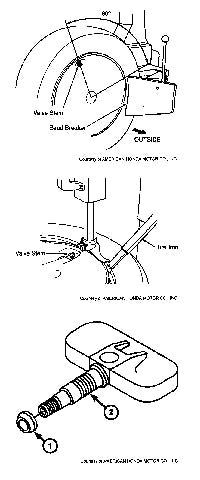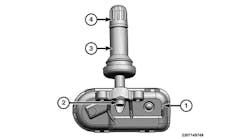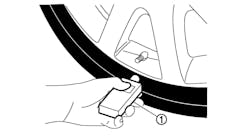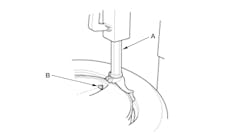SUBJECT VEHICLE: 2008-2013 Honda Fit.
RELEARN PROCEDURE? Yes.
SPECIAL TOOLS NEEDED? Yes. The ATEQ VT55 tool or the TPMS Sensor Tool AKS0620006.
When a tire pressure sensor or control unit is replaced on a 2008-2013 Honda Fit, or a known good wheel is substituted, the ID(s) of all four tires’ sensors must be memorized by the TPMS control unit. After memorizing the sensor ID(s) or doing a tire rotation, the mounting location of sensors 1, 2, 3 and 4 must be determined. See Reset procedures.
NOTE: The Honda Diagnostic System (HDS) or an OBD-II compatible scan tool and an ATEQ VT55 tool (recommended), or the TPMS sensor tool AKS0620006 must be used to program information into the new TPMS control unit with both of the reset procedures. The TPMS sensor tool (AKS0620006) has been superseded by the ATEQ VT55 tool, and is recommended for use on all Honda vehicles.
Tire pressure monitoring system
The tire pressure monitoring system (TPMS) consists of a low tire pressure indicator, TPMS indicator and TPMS control unit. The TPMS control unit monitors all four tires, the system, and alerts the driver if there is a large change in the tire pressure or a system problem by illuminating the appropriate indicator.
When the vehicle speed exceeds 28 mph (45 km/h) the tire pressure sensor begin to transmit. The tire pressure sensor transmits its ID and tire pressure, using a RF (radio frequency) signal, to the TPMS control unit once every 60 seconds. In this stage the tire pressure sensors enter into “normal function mode.” When the vehicle is stationary for five minutes or more, the tire pressure sensors enter into “sleep mode” to reserve the battery life.
Each sensor is an integrated unit made up of the tire valve stem, a pressure sensor and a transmitter. The unit is attached to the inside of the wheel, around the valve stem. Each low pressure sensor has its own ID to prevent jamming by similar systems on other vehicles. After memorizing all the sensor ID(s), the control unit receives only those specific signals.
NOTE: Tire pressure sensor ID memorizing is required if the TPMS control unit or sensor is replaced.
TPMS warning indicators
NOTE: Tire pressures will increase slightly as the temperature in the tires rises during driving at highway speeds. Pressures will also increase or decrease slightly with changes in outside air temperature.
A temperature change of about 18 degrees Fahrenheit (10 degrees Celsius) will change tire pressure by about 1.5 psi (10 kPa). If the temperature drops outside, the tire pressure could decrease just enough to turn on the low tire pressure indicator. After the outside temperature increases, the low tire pressure indicator will turn off. To resolve a complaint of such intermittent indications, confirm and clear the stored DTC(s) and check the tire pressures. Then explain to the customer how temperature changes can affect the system, especially when tire pressures are near the low end of the TPMS normal range of 24 to 32 psi (168 to 220 kPa).
NOTE: If the outside temperature is at or below -40 degrees F (-40 degrees C), the system may not function properly.
If the system detects low pressure in any of the four tires, the low tire pressure indicator comes on. When the indicator comes on, inflate the tires and test drive the vehicle at 28 mph (45 km/h) or more for at least one minute, and the low tire pressure indicator will go off.
If the control unit detects a problem in the system during an indication of low tire pressure, it turns off the low tire pressure indicator, stores the DTC(s), and turns on the TPMS indicator.
The TPMS indicator will come on if the following has occurred:
- If a problem is detected in the system.
- If low tire pressure and a problem in the system is detected.
- If the TPMS control unit loses power or fails.
Reset procedures
NOTE: When a tire pressure sensor or control unit is replaced, or a known good wheel is substituted, the ID(s) of all four tires’ sensors must be memorized by the TPMS control unit. See Memorizing sensor ID. After memorizing the sensor ID(s) or doing a tire rotation, the mounting location of sensors 1, 2, 3 and 4 must be determined (see sensor location).
NOTE: The Honda Diagnostic System (HDS) or an OBD-II compatible scan tool and an ATEQ VT55 tool (recommended), or the TPMS sensor tool AKS0620006 must be used to program information into new TPMS control unit with both of the reset procedures. The TPMS Sensor Tool (AKS0620006) has been superseded by the ATEQ VT55 tool, and is recommended for use on all Honda vehicles.
NOTE: If a flat tire is replaced with the spare tire, the TPMS indicator will come on, and DTC(s) will be set, because the system is no longer receiving the signal from the flat tire’s transmitter. This does not indicate a problem with the spare tire. When the indicator comes on, inflate the tires and test drive the vehicle at 28 mph (45 km/h) or more for at least one minute, and the low tire pressure indicator will go off.
Tire pressure sensor memorization
NOTE: To ensure the control unit memorizes the correct ID, the vehicle with the new sensor must be at least 10 feet from any other TPMS pressure sensor not installed on that vehicle.
Memorizing sensor ID
NOTE: The TPMS tool ATEQ VT55 (recommended), or the TPMS sensor tool AKS0620006 is necessary to perform this procedure. For AKS0620006, verify that the power switch is in the “Low” position. If the power switch is in the “High” position, more than one sensor or sensors on other vehicles may be activated.
1) Turn the ignition switch to the LOCK position and wait five minutes for the tire pressure sensor to enter into “sleep mode.”
2) Connect the HDS to the Data Link Connector (DLC) located under the left side of the dashboard.
3) Turn the ignition switch to the ON position, and verify that the HDS is communicating with the TPMS control unit.
4) Select “Sensor ID Learning” on the HDS tool.
NOTE: If the vehicle’s ignition switch is turned to the LOCK position before all sensors are memorized, the memorizing ID is canceled.
5) After turning on the vehicle, hold the ATEQ VT55 tool (recommended), or the TPMS sensor tool AKS0620006 near the valve stem on one wheel, and memorize the pressure sensor ID by following the screen prompts on the HDS. If the TPMS control unit is still having trouble learning ID(s), refer to the appropriate service information.
6) Repeat step 5 for each wheel until all four sensor ID(s) are memorized. When all are memorized, the low tire pressure indicator will blink.
7) Turn the ignition switch to the LOCK position and disconnect the HDS from the Data Link Connector (DLC).
8) Test drive the vehicle at 28 mph (45 km/h) or more for at least one minute. Monitor the low pressure indicator to be certain it does not blink.
9) Make sure the tires are inflated to the specified tire pressure listed on the doorjamb sticker.
[PAGEBREAK]
Sensor location
NOTE: This procedure locates where the tire pressure sensors 1, 2, 3 and 4 are mounted, when activated by the ATEQ VT55 tool (recommended), or the TPMS sensor tool AKS0620006.
- Position the vehicle at least 10 feet away from other vehicles that have tire pressure sensors.
- Let the vehicle sit for at least five minutes to allow the sensors to switch to the sleep mode.
1) With the ignition in the LOCK position, connect the HDS to the Data Link Connector (DLC) located under the left side of the dashboard.
2) Turn the ignition switch ON, and verify that the HDS is communicating with the TPMS control unit.
3) Select “Function Test” then “Sensor Position Check” on the HDS tool. NOTE: For the AKS0620006 tool, verify that the power switch on the tool is in the “Low” position. If the power switch is in the “High” position, more than one sensor or sensors on other vehicles may be activated.
4) Follow HDS screen prompts to turn on the ATEQ VT55 tool (recommended), or the TPMS sensor tool AKS0620006.
5) Follow the prompts on the HDS to activate the tire pressure sensors using the ATEQ VT55 tool (recommended), or the TPMS sensor tool AKS0620006.
NOTE: If the tire pressure sensor does not respond to the TPMS sensor initializer, rotate the tire 1/4 turn and repeat step 5. If the tire pressure sensor does not respond after a complete rotation with the current tire and switching the tire to a good known location, replace the tire pressure sensor.
6) Check the HDS screen, and note the active sensor reception order of tire pressure sensors 1, 2, 3 and 4.
7) Turn the ignition switch to the LOCK position.
Demounting/mounting procedures
NOTE: When a tire pressure sensor is replaced, the sensor ID must be memorized by the TPMS control unit. See Reset procedures. NOTE: Vehicles equipped with TPMS must use wheels made for the system, or the system will not work. On all models, a “TPMS” mark is visible on the wheel, and a counterweight is cast into the opposite side of the spoke to balance the weight of the sensor.
Tire pressure sensor
CAUTION: Fluid sealant used to repair a punctured tire can damage the tire pressure sensor mounted on each wheel. It can prevent the system from detecting the correct tire pressure and set a DTC even though the system is normal.
Removal
1) Raise the vehicle and support it with safety stands in the proper locations.
2) Remove the wheel with the faulty sensor.
3) Remove tire valve cap and valve core, and let the tire deflate.
4) Remove any balance weights, and then remove the tire from the wheel with a tire changer. Note these items to avoid damaging the tire pressure sensor:
- Do the outside of the wheel first. Position the wheel as shown so the valve stem is 90 degrees from the bead breaker (see Figure 1).
- DO NOT position the bead breaker of the tire changer too close to the rim.
Position the wheel so the tire machine and tire iron are next to the valve stem, and will move away from it when the machine starts. Then remove the tire from the wheel (see Figure 2).
5) Remove the valve stem nut and washer, and then remove the tire pressure sensor with valve stem from the wheel.
NOTE: The valve stem grommet might stay in the wheel; make sure to remove it.
6) Remove and discard the valve stem grommet from the tire pressure sensor (see Figure 3).
Installation
NOTE: Use only wheels that have a “TPMS” stamp (A) on the inside of the aluminum wheels, and the outside of the steel wheels.
1) Clean the mating surfaces on the sensor and the wheel before installing the tire pressure sensor.
2) Install the tire pressure sensor and washer to the wheel, and tighten the valve stem nut finger tight. Make sure the sensor is resting on the wheel (see Figure 4).
NOTE: Do not use air or electric impact tools to tighten a valve stem nut.
3) Tighten the valve nut to 35 in.-lbs. (4 N.m) while holding the tire pressure sensor toward the wheel.
4) Lube the tire bead sparingly with a paste-type tire mounting lubricant, and position the wheel so the tire machine and tire iron are next to the valve stem and will move away from it when the machine starts. Then install the tire onto the wheel.
5) Inflate the tire to 44 psi (300 kPa) to seat the tire bead to the rim, then adjust the tire pressure to specification as indicated on the tire and loading information placard, and install the valve stem cap.
6) Check and adjust the wheel balance, then install the wheels onto the vehicle.
7) Remove the safety stands and lower the vehicle.
8) Memorize the pressure sensor ID(s). See Reset procedures for details. ■
Information for this column comes from Mitchell 1’s “Tire Pressure Monitoring Systems Guide” for domestic and import vehicles through 2013. Headquartered in Poway, Calif., Mitchell 1 has provided quality repair information solutions to the automotive industry for more than 80 years. For more information, visit www.mitchell1.com.
To see more TPMS columns, click:
2005-11 Volvo V Series service
Train Mustang sensors when the front and rear pressures differ




